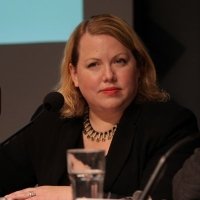Talking Science: Environmental and Health Communications in a Skeptical Era
Communicating complex scientific concepts to general audiences is difficult given today’s information overload. Capturing the attention of time-pressed policymakers long enough to explain multifaceted issues like climate change and global health is an even greater challenge. The Environmental Communications Division of the National Communication Association co-sponsored two panels at the Wilson Center on November 22 featuring communication directors and professors of communications to explore this issue.
“Put the Hay Down Where the Goats Can Get It”
“What all communicators are dealing with right now is an increasingly fragmented news information marketplace…that’s far from settling down,” said Laurie Boeder, director of health communications at the Pew Charitable Trusts. “People now go out and find their own sources of news, so increasingly thinking about the audience that you want to reach, what you want to tell them, and what you want them to do with that information when they get it is essential,” she said, or what she called “putting the hay down where the goats can get it.”
On the bright side, “we have an incredible opportunity now to produce content and reach audiences in a way that we never would have before,” said Dilly Severin, director of communications at Population Action International (PAI). She explained how an interactive map produced by PAI shows the connections between family planning, food security, and climate change vulnerability in many countries. “These visualizations…they transcend culture, they transcend language,” said Boeder.
Making connections like these between health and climate change is one way to start productive conversations, said Bob Deans, associate director of communications at the Natural Resources Defense Council, because people want to know what climate change means for them and what they can do as individuals. “When we can connect the dots, when we can put a human face on the dangers, the costs, and the rising risks and hazards of climate change, we tend to get people’s attention,” he said. “When we talk about parts per million of CO2 in the atmosphere and the 14 hottest years on record since 1997, we tend to lose people’s attention.”
Rebecca Bertram of the Heinrich Böll Foundation says her organization also focuses on making personal connections, but with a more positive spin. In Germany, which has committed to meeting 80 percent of its electricity needs with renewables by 2050, “we are now debating on how best to solve the problem,” rather than debating the causes of climate change, she said. The country’s energy transition “enables ordinary citizens, farmers, and rural communities to get involved in [renewable energy cooperatives] and collectively invest in renewable energy projects.”
Getting Past Differences in the Internet Age
The sheer amount of information available today makes it challenging for the average reader to filter facts from opinions, explained George Washington University’s Michael Svoboda, who also writes for the Yale Forum on Climate Change and the Media.
Peter Jacques of the University of Central Florida suggested that the inaccessibility of scientific findings in peer-reviewed journals and conferences contributes to public misconceptions about politicized issues like climate change. His research with Riley Dunlap from Oklahoma State University found that at least 90 percent of the books challenging anthropogenic climate change have not undergone peer review, the standard of acceptance in the scientific realm.
Political inertia compounds the inaccessibility of peer-reviewed science: “All [climate skeptics] have to do is sow enough doubt to prevent change…where [climate activists] have to instill enough confidence to enact change,” said Deans.
In Brazil, “meat consumption would be the obvious discussion if the national discussions were to reflect the national emissions profile,” as 50 percent of its greenhouse gas emissions are from cattle production, said Myanna Lahsen from the National Institute of Space Research. Instead, discussions in the media generally center on the need to reduce deforestation without going into much detail. “There is very little probing…getting at the drivers and getting to these issues that hurt,” she said.
On the other hand, some global health issues, like expanding access to family planning, suffer more from public disinterest than misconceptions, making it difficult to get attention unless you “pick a fight,” said Sandra Jordan, senior technical advisor for external affairs at the U.S. Agency for International Development’s Office of Population and Reproductive Health. Since USAID is nonpartisan, she relies on “constituencies and coalition building…to get the word out.”
Given these challenges, population-environment connections, like those explored by PAI and USAID, are doubly difficult to communicate, but Severin helps by providing the language and tools that can engage environmentalists while respecting human rights. “We’re not talking about target numbers or trying to stop women from having children. Our conversation is about how can we fulfill their right to choose the size of their families, and then the benefits that flow from that for themselves, and then for the environment, and for their communities,” said Severin.
“What we have to do is to make this science real and understandable for people when they sit down at their kitchen table, when they look out their window, when they wander around in their own backyard,” said Deans. “It can be done, because after all, science is the story of what is happening to our world. We just have to tell that story in a way that connects with people.”
Event Resources:
Drafted by Laura Henson, edited by Schuyler Null and Meaghan Parker.
Speakers

Executive Director, Council for the Advancement of Science Writing
Hosted By

Environmental Change and Security Program
The Environmental Change and Security Program (ECSP) explores the connections between environmental change, health, and population dynamics and their links to conflict, human insecurity, and foreign policy. Read more
